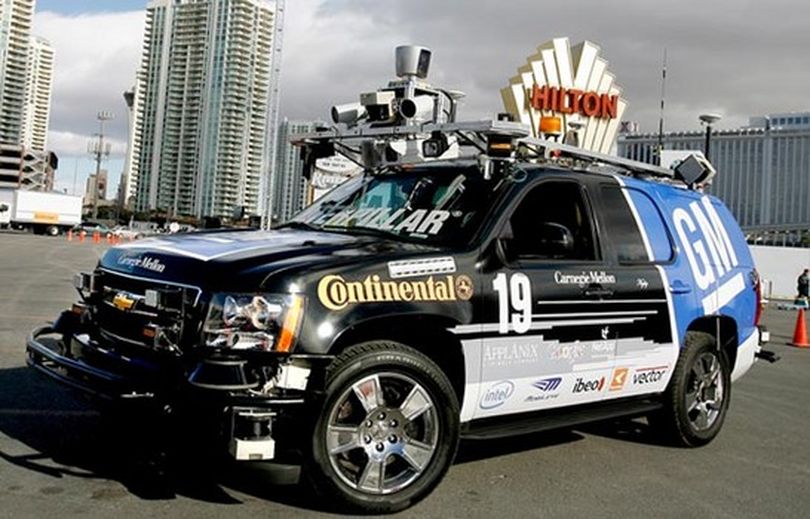Yikes? Technology to keep seniors driving longer

We’ve all seen the cliché elderly person in a powder blue Cadillac doing a righteous 48mph on the freeway with their turn signal on. It’s annoying, dangerous and according to several new studies these active members of the greatest generation should be allowed to drive even longer with the help of technology.
“For many older people, particularly those living alone or in rural areas, driving is essential for maintaining their independence, giving them the freedom to get out and about without having to rely on others,” said Professor Phil Blythe of Newcastle University.
“But we all have to accept that as we get older our reactions slow down and this often results in people avoiding any potentially challenging driving conditions and losing confidence in their driving skills. The result is that people stop driving before they really need to.”
“What we are doing is to look at ways of keeping people driving safely for longer, which in turn boosts independence and keeps us socially connected.”
As part of nearly $20million program under Blythe’s direction a team of Newcastle researchers converted an electric car into a ‘DriveLAB’ outfitted with tracking systems, eye trackers and bio-monitors to gather information on what contributes to senior drivers’ unique challenges. The systems track things such as eye movement, speed, reaction, lane position, acceleration, braking and driving efficiency.
The Newcastle team tested older guinea pigs from the North East and Scotland in the DriveLAB as well as the University’s driving simulator to shed light on their driving habits, fears and ways to possibly mitigate them with technology.
Dr. Amy Guo, the leading researcher on the study, explained: “…Most of us would expect older drivers always go slower than everyone else but surprisingly, we found that in 30mph zones they struggled to keep at a constant speed and so were more likely to break the speed limit and be at risk of getting fined.”
“We’re looking at the benefits of systems which control your speed as a way of preventing that.”
Other vehicle technologies the DriveLAB team is developing include night vision systems and a navigation tool dubbed the “granny nav.”
Versus instructing drivers to follow directions by street names and distance cues the granny nav tells them to turn at landmarks that are easier to notice, such as a gas station, McDonalds, mailbox, etc.
Hold on a second… I’m twenty seven years old and that sounds like a technology I would use. According to an eye test I squinted through at the DMV when I was sixteen I don’t need glasses. But that doesn’t keep me from cursing SAT NAV systems when I miss their verbal turn cues; street signs are hard to spot when navigating traffic.
DriveLAB researcher Chris Emmerson, explained: “One thing that came out of the focus groups was that while the older generation is often keen to try new technologies it’s their lack of experience with, and confidence in, digital technologies which puts them off. Also, they felt most were designed with younger people in mind.”
I wish the granny navy actually was designed for me – I would use it.
I see a trend forming here. In September of this year The Harford and MIT AgeLab released a study listing their top technology recommendations for mature drivers:
1. Smart headlights: adjust the range and intensity of light based on the distance of traffic and to reduce glare and improve night vision
2. Emergency response systems: offer quick assistance to drivers in the case of a medical emergency or collision, often allowing emergency personnel to get to the scene more quickly
3. Reverse monitoring systems: warn of objects to the rear of the vehicle to help drivers judge distances and back up safely, and helps drivers with reduced flexibility
4. Blind spot warning systems: warn drivers of objects in blind spots, especially while changing lanes and parking, and helps those with limited range of motion
5. Lane departure warning: monitors the vehicle's position and warns the driver if the vehicle deviates outside the lane, helping drivers stay in their lane
6. Vehicle stability control: helps to automatically bring the vehicle back in the intended line of travel, particularly in situations where the driver underestimates the angle of a curve or experiences weather effects, and reduces the likelihood of a crash
7. Assistive parking systems: enable vehicles to park on their own or indicates distance to objects, reducing driver stress, making parking easier, and increasing the places that a driver can park
8. Voice activated systems: allow drivers to access features by voice command so they can keep focused on the road
9. Crash mitigation systems: detect when the vehicle may be in danger of a collision and can help to minimize injuries to passengers
10. Drowsy driver alerts: monitor the degree to which a driver may be inattentive while on the road and helps alert drivers to the driving task
Just about every recommendation on the list is a safety option that’s becoming more standardized on upper-end cars. Whether you’re a senior citizen who needs some help keeping up with younger motorists or just a crappy driver they’re designed to compensate for human error.
This list also spotlights the fact that with these new technologies cars are moving closer to being able to drive themselves. That’s good news for seniors who can’t rely on Access buses or a caretaker to get them out of the house for every trip.
Exactly when seniors become too old to drive is a matter of discretion that needs to be regulated more closely and researched further to do so. For now let’s hope powder blue Cadillac’s of the future will come standard with a ‘senior’s technology package’.
SOURCES:
Picture: Automedia.com
